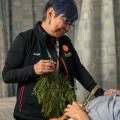Cardiac CT & MRI scans
Learn more about the cardiac scans that help to guide treatment for your heart condition.
Overview
Health care professionals use a CT scan to see structures of the heart. The scan looks mainly at the heart muscle and large blood vessels.
These blood vessels include coronary arteries, pulmonary veins, the thoracic and abdominal aorta and more. The test can also be performed using Magnetic Resonance Imaging (MRI). MRI is a non-radiation based scan that uses high powered magnets to see inside the body. CT and MRI provide overlapping but different information. Your care team may prefer either based on your symptoms and/or physical limitations you may have. Both are non-invasive procedures and pain-free.
Cardiac Computed Tomography (CT) Scan
A cardiac computed tomography (CT) scan uses many X-rays from different angles. These X-rays build images of your heart using a scanner and computer. This detailed scan is high-resolution. It shows the radiologist any concerns with your heart's structure, valves, arteries, aorta and more.
Cardiac MRI (Magnetic Resonance Imaging)
We use cardiac MRI to see the structure and function of your heart, valves, and major arteries and veins. The MRI machine uses radio-frequency waves and very strong magnets to produce images of the body. It does not use radiation. The MRI scanner (magnet) has a donut-shaped opening to a tunnel that a table moves into. For the exam, you will be inside this tunnel for the duration of the scan.
MRI images are able to show different kinds of details than CT scans and can be viewed in 3-D on a computer screen.
Preparing for the test
Cardiac Computed Tomography (CT) Scan
The CT scanner has a large opening that a table moves through. Some people refer to this opening as the “donut hole.”
The cardiac CT takes one to three hours to complete. The time depends on your resting heart rate.
Cardiac MRI (Magnetic Resonance Imaging)
MRI exams can be quite long. You should expect your exam to last 1-2 hours. If you are claustrophobic (scared of small, closed spaces), please tell your referring physician. They may be able to prescribe a mild sedative to help you get through your MRI. It is important that you do not fall asleep during the scan. This is because the technologist will ask you to hold your breath regularly throughout the MRI.
During the test
Support for Indigenous Peoples
The Indigenous Wellness Liaison Team is here to support your health journey. Team members offer cultural support and healthcare advocacy. Learn more below or call them at 604-682-2344,62937 or email IWL@providencehealth.bc.ca.

